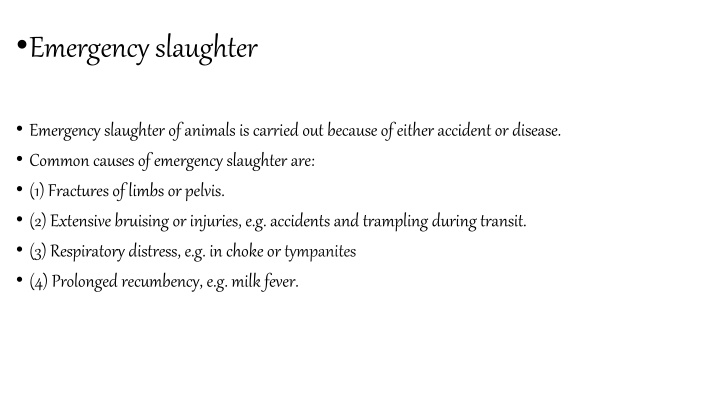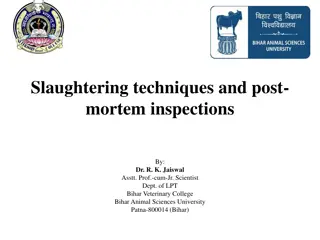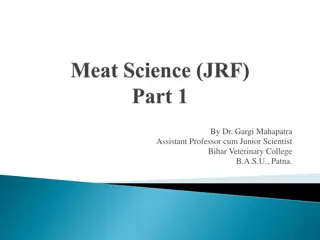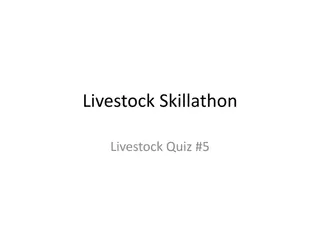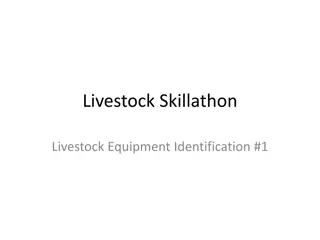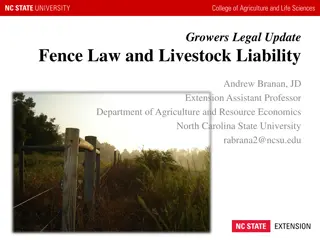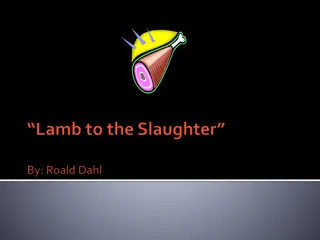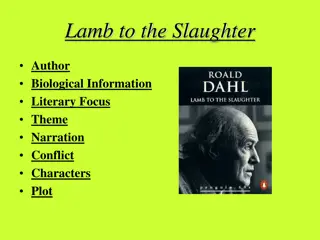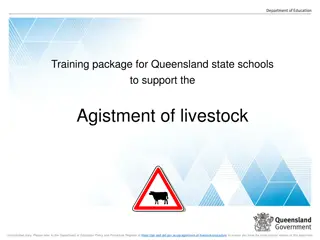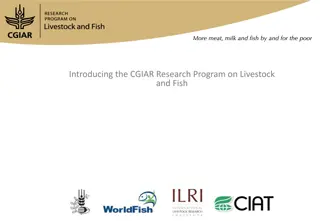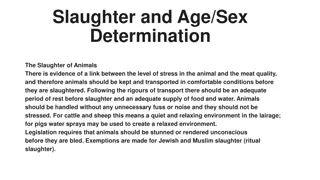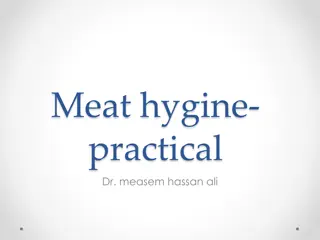Emergency Slaughter Procedures in Livestock Management
Emergency slaughter of animals is conducted in cases of accidents or diseases, with common reasons including fractures, injuries, respiratory distress, difficult parturition, and others. Electrical stimulation of carcasses is employed for benefits like increased tenderness and flavor. Hot deboning of carcasses is a modern hygienic practice for efficient meat removal. Understanding the muscular system helps in recognizing strains and injuries in animals.
Download Presentation

Please find below an Image/Link to download the presentation.
The content on the website is provided AS IS for your information and personal use only. It may not be sold, licensed, or shared on other websites without obtaining consent from the author.If you encounter any issues during the download, it is possible that the publisher has removed the file from their server.
You are allowed to download the files provided on this website for personal or commercial use, subject to the condition that they are used lawfully. All files are the property of their respective owners.
The content on the website is provided AS IS for your information and personal use only. It may not be sold, licensed, or shared on other websites without obtaining consent from the author.
E N D
Presentation Transcript
Emergency slaughter Emergency slaughter of animals is carried out because of either accident or disease. Common causes of emergency slaughter are: (1) Fractures of limbs or pelvis. (2) Extensive bruising or injuries, e.g. accidents and trampling during transit. (3) Respiratory distress, e.g. in choke or tympanites (4) Prolonged recumbency, e.g. milk fever.
(5) Difficult parturition. (6) Partial asphyxiation occurring often in pigs during transit. (7) Heat stroke this also occurs in pigs during transit in hot weather. It is important to bear in mind the possibility of anthrax in emergency slaughter. The carcass and offal in any case of emergency slaughter should receive a very thorough inspection, and if there is any doubt, samples should be submitted for bacteriological examination.
Electrical stimulation of Electrical stimulation of carcasses carcasses Benefits claimed for this process are as follows: (1) Tenderness is increased by up to 30%. (2) Flavouris increased by up to 10%. (3) Colourof the meat is better by 10%. (4) It enables hot boning immediately after slaughter. (5) The meat keeps longer and is said to have a shorter cooking time.
(6)Ithelpsinthebleedingprocess. (7)Itpreventscoldshorteninginlambs. There are various methods of carrying out the process, but probably the best and safest is theone usingalow-voltagestimulation unit,whichisearthedthroughtheoverheadrailand itsownearth. Immediately after sticking, a skull probe is inserted into the skull through the hole made by the captive bolt. A charge of 90 volts is applied for about 30 seconds. In cattle the probe passesthroughthemedullaandintothespinalcord.
Hot deboning of carcasses Hot deboning of carcasses A very high degree of hygiene is required in this fairly recent innovation. Instead of removing the meat from cold joints the meat is removed from the warm carcass. The muscles are seamed out to a great extent so that there is less drip loss and there is a better color and shape to the final product. A side of beef can be deboned by one operative in less than 1 hour.
MuscularSystem Themovementsofanimalsarebroughtaboutbythecontraction ofmuscles. The muscles contract or shorten in response to impulses conveyedtothembynerves. Muscles only stretch beyond the normal in abnormal situations resultinginstrainsor tornmuscles.
Muscle tissue is composed of small elongated cells or muscle fibres. These are bound in bundles by connective tissue. The fibresvary in size but average 2.5cm * 0.05mm. They are cylindrical in shape with rounded ends. Many become elongated into tendons, which attach or insert into bones. The fibresconsist of a sheath or sarcolemma enclosing the contractile substance.
Composition of Meat Meat is defined by the Codex Alimentarius as All parts of an animal that are intended for, or have been judged as safe and suitable for, human consumption . Meat is composed of water, protein and amino acids, minerals, fats and fatty acids, vitamins and other bioactive components, and small quantities of carbohydrates.
Nutritional composition of meats per 100g** Product Water Beef (lean) Beef carcass 54.7 Pork (lean) Pork carcass 41.1 Veal (lean) Chicken 75.0 Venison (deer) Beef fat (subcutaneous)4.0 1.5 Protein Fat Ash kJ* 75.0 22.3 1.8 1.2 485 16.5 28.0 0.8 1351 75.1 22.8 1.2 1.0 469 11.2 47.0 0.6 1975 76.4 21.3 0.8 1.2 410 22.8 0.9 1.2 439 75.7 21.4 1.3 1.2 431 94.0 0.1 3573 Pork fat (back fat)7.7 2.9 88.7 0.7 3397
Lean red meats are: An excellent source of high biological value protein, vitamin B12, niacin, vitamin B6, iron,zincandphosphorus A source of long-chain omega-3 polyunsaturated fats, riboflavin, pantothenic acid,
seleniumandpossiblyalsovitaminD Mostlylowinfatandsodium Sourcesofarangeofendogenousantioxidantsandotherbioactivesubstance
Meat quality Meat quality is normally defined by the compositional quality (lean to fat ratio) and the palatability factors such as visual appearance, smell, firmness, juiciness, tenderness, and flavour. The nutritional quality of meat is objective yet "eating" quality, as perceived by the consumer, is highly subjective.
Visual Identification Visual Identification The visual identification of quality meat is based on colour, marbling and waterholdingcapacity. Marbling is small streaks of fat that are found within the muscle and can be seen in the meat cut. Marbling has a beneficial effect on juiciness and flavourof meat. Meat should have a normal colourthat is uniform throughout the entire cut. Beef, lamb, and pork should also have marbling throughout the meat.
Smell Smell Another quality factor is smell. The product should have a normal smell. This will be different for each of the species (i.e. beef, pork, chicken), but should vary only slightly within the species. Any rancid or strange smelling meat should be avoided.
Firmness Meat should appear firm rather than soft. When handling the retail package, it should be firm, but not tough. It should give under pressure, but not actually be soft.
Juiciness Juiciness depends on the amount of water retained in a cooked meat product. Juiciness increases flavour, helps soften meat - making it easier to chew, and stimulates saliva production in the mouth. Water retention and lipid content determine juiciness. Marbling and fat around edges helps hold in water. Water losses are from evaporation and drip losses. Meat aging can increase water retention and therefore increases juiciness.
Tenderness Has been linked to several factors, such as the animal's age, sex or the muscle location. One important way to tenderize meat is by aging. Carcasses are aged by holding them at refrigeration temperatures for extended periods of time after slaughter and initial chilling.
Flavour Flavourand aroma are intertwined to create the sensation the consumer has during eating. These perceptions rely on the smell through the nose and on the sensations of salty, sweet, sour and bitter on the tongue. Meat flavouris affected by type of species, diet, cooking method and method of preservation (e.g. smoked or cured).
